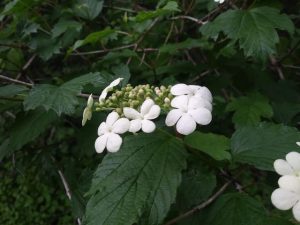maple leaf viburnum
Viburnum acerifolium

Description:
Stems:
Leaves: 3-lobed leaves
Flowers: Flat-topped clusters of white flowers
Fruit/Seeds: Berries turning from red to blue-black.
Locations:
Found in woodlands.
Impact:
Provides good nesting and escape cover for numerous species of birds and small mammals. The fruits of mapleleaf viburnum are eaten by white-tailed deer, rabbits, mice, skunks, ruffed grouse, ring-necked pheasants, wild turkeys, and many species of songbirds. The twigs, bark, and leaves are eaten by white-tailed deer, moose, rabbits, and beavers.
maple leaf viburnum
[wi_plants_standard_vw filter="attr::emd_usda_symbol::is:: VIAC;"]
[wip_eco_standard_vw filter="attr::emd_usda_symbol::is:: VIAC;"]
[wip_legal_standard_vw filter="attr::emd_usda_symbol::is:: VIAC;"]
[wip_morph_standard_vw filter="attr::emd_usda_symbol::is:: VIAC;"]
[wip_require_standard_vw filter="attr::emd_usda_symbol::is:: VIAC;"]
[wip_repro_standard_vw filter="attr::emd_usda_symbol::is:: VIAC;"]
[wip_use_standard_vw filter="attr::emd_usda_symbol::is:: VIAC;"]
References:
- Fire Effects Information System (FEIS) – Viburnum acerifolium
- iNaturalist Database – Viburnum acerifolium
- Morton arboretum Database – Viburnum acerifolium
- NRCS Plant Guide – Viburnum aceifolium
- Baird, John W. 1980. The selection and use of fruit by birds in an eastern forest. Wilson Bulletin. 92(1): 63-73
- Gill, John D.; Pogge, Franz L. 1974. Viburnum L. Viburnum. In: Schopmeyer, C. S., ed. Seeds of woody plants in the United States. Agriculture Handbook No. 450. Washington: U. S. Department of Agriculture, Forest Service: 844-850.
Click here for the Native Plants Page
